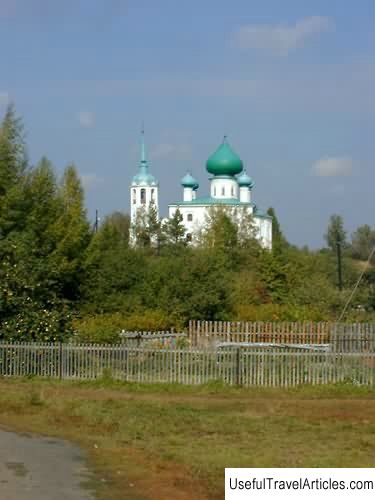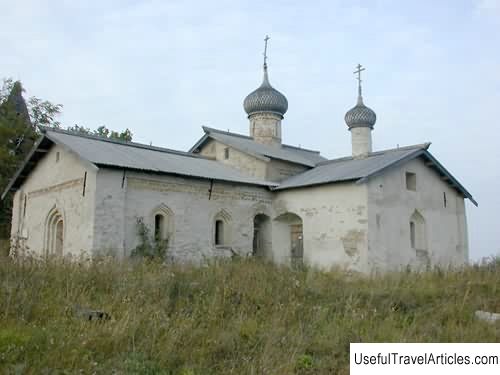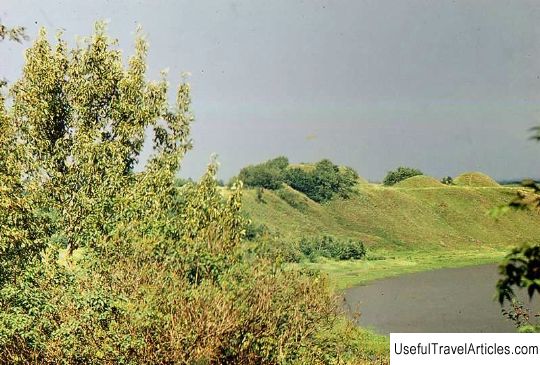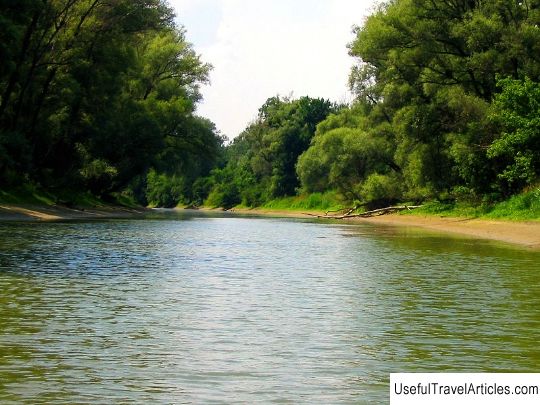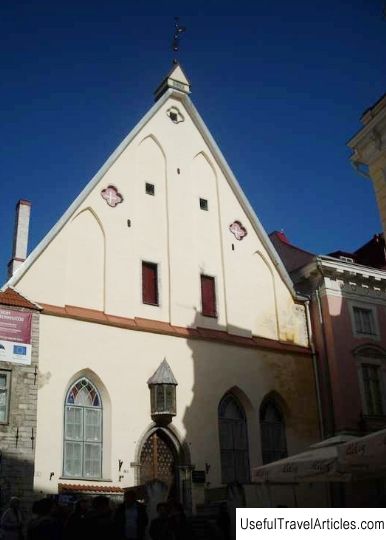Staraya Ladoga fortress description and photos - Russia - Leningrad region: Staraya Ladoga
Rating: 8,3/10 (800 votes) 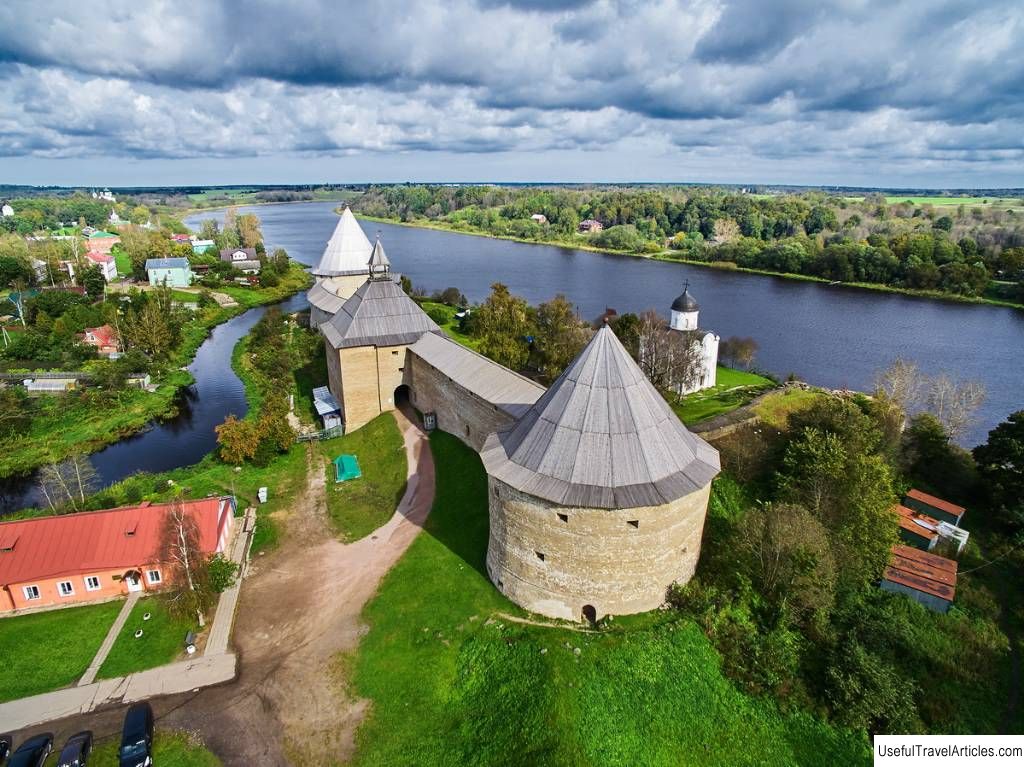
Staraya Ladoga fortress description and photos - Russia - Leningrad region: Staraya Ladoga. Detailed information about the attraction. Description, photos and a map showing the nearest significant objects. Photo and descriptionStaraya Ladoga is one of the most ancient trading settlements in Northern Russia. Once there was the residence of Prince Rurik . Now you can see a powerful fortress of the XV-XVI centuries, the church of St. George of the XII century with unique paintings, a museum exhibition in one of the towers with the richest archaeological collection and much more. History of the fortressThe first written mention of Ladoga dates back to 1010, that is, Old Ladoga of ancient Moscow . Archaeologists claim that a settlement existed here already in the 7th-8th centuries: the remains of houses, hearths and barns were found. It is believed that the first inhabitants were Scandinavians, and only then Slavic tribes came here. The fortified settlement stood on the trade route "from the Varangians to the Greeks" , grew and grew rich due to trade. Here, for example, Arab coins of the 8th century and jewelry typical for Bulgaria were found - this means that trade was conducted with the south. It produced glass beads with "eyes" - the most fashionable jewelry of that time. It is believed that it was Ladoga who made Rurik his residence. The rich city was destroyed several times. Very early, already in the X century, a stone fortress arose here - under the famous Prophetic Oleg , Novgorod and Kiev prince. Its remains were found by archaeologists in the 70s of the XX century, however, these findings can be questioned. The fact is that the remains of the next fortress, the 11th century, are again wooden. One way or another, the fortress was surrounded by high ramparts, and the bend of two rivers - Ladozhka and Volkhov - was blocked off by a specially dug ditch, that is, the fortress ended up on an artificial island. Since the XIV century, Ladoga has been repeatedly attacked by the Swedes - it was taken, then they beat back. The current fortifications date back to the 16th century: like many other northern fortresses, during these years the Old Ladoga fortress was being rebuilt in accordance with the requirements of the new era. Firearms spread, artillery reached a new level - all this required the construction of new walls and towers. After the Northern War Staraya Ladoga lost its strategic importance. Peter I founded Novaya Ladoga , in a place that he considered more suitable. Staraya Ladoga has lost its city status - at the moment it is a village. By the end of the 19th century, she fell into desolation, but by this time archaeologists were interested in her. Since 1884, scientific excavations began here. The main research in Ladoga was carried out in the 30s of the XX century under the leadership of the famous archaeologist Vladimir Bogusevich , who during these years explored Pskov and Novgorod. St. George and St. Dimitri of Thessaloniki There are two unique churches on the territory of Staraya Ladoga. Church of St. George presumably built in the XII century in honor of another victory over the Swedes - this is generally one of the oldest churches in the Russian north. She was rebuilt several times, and at the beginning of the 20th century it was already completely different from the original. The building grew into the ground by one and a half meters, the floor, accordingly, rose many times, a new porch and a bell tower were added to the church. In the 20th century, the temple was restored in its original forms, and on the camps and in the altar were opened 12th century frescoes . About a fifth of all the paintings have survived. The most interesting of these is the altar fresco depicting St. George defeating the dragon. It is inscribed in the concave altar apse: the artist who painted it took into account the distortion of the image. The fresco is written so as to appear even, even taking into account the curvature of the walls. The unique wooden Church of Dmitry Solunsky was built in 1732 . It was badly dilapidated by the end of the 19th century, but at the beginning of the 20th, against the backdrop of a fascination with antiquity, it was restored in its former forms at the expense of the local merchants. This is one of the oldest wooden churches in Russia. After the revolution, it was transferred to the museum and it housed an exposition telling about the peasant life . Nothing remained of the interior decoration. Now there is an exhibition of frescoes of the church of St. George and sometimes, by agreement with the museum, services are held. Museum Now Staraya Ladoga Fortress is a museum . Its towers and walls were built in the 15th century and significantly rebuilt in the 16th century. The walls are relatively low - on average about 10 meters in height, but they are exceptionally strong. Their thickness in some places reaches 7 meters, they were built in order to withstand artillery strikes. The fortress was significantly destroyed by the end of the 19th century. In the course of the post-war restoration, two towers , Vorotnaya and Klimentovskaya, and a section of the wall were completely restored, the rest was mothballed. The Raskatnaya, Strelochnaya and Taynitskaya towers are still in a dilapidated state. excavations are continuing on the territory of the fortress. The exposition of the museum is now located in the Gate Tower. The museum appeared here back in 1971 . It occupies two tiers of the tower. One of the exhibitions tells about the very first settlements in these territories, dating back to the Neolithic, and about the funeral rite of that time, the other reveals the numerous trade ties of medieval Ladoga, and finally the latter tells about the city life and the military history of the fortress. Another part of the fortress accessible for inspection is Earthen City . These are earthen ramparts, built at the end of the 17th century as an additional fortification. Judging by the archaeological data, the original settlement was exactly here. Varyazhskaya streetVaryazhskaya street departs from the fortress - it is considered one of the most ancient streets in Russia . It has preserved wooden buildings of the 19th century, and recently a bronze "Attacking Falcon" was installed - a symbol of Staraya Ladoga and the Rurik family itself. There is also a monument to two princes - Rurik and Prophetic Oleg, by sculptor Oleg Shorov. It also appeared in the 21st century. In one of the merchant mansions, the wooden house of the merchant A. Kalyazin, there is now a museum dedicated to the Ladoga merchants . The stone house, which has belonged to the same family since 2003, houses an archaeological exhibition. It contains over a thousand items found here during excavations. Monasteries In addition to the fortress in Staraya Ladoga, it is worth seeing two monasteries, male and female. The Old Ladoga Nikolsky Monastery was founded by Alexander Nevsky after the Battle of the Neva, and now you can see the St. Nicholas Cathedral of the 18th century and the interesting church of St. John Chrysostom, XIX century, built in the pseudo-Russian style. In the Old Ladoga Dormition Monastery , the Dormition Cathedral of the 12th century with the remains of ancient frescoes, as well as buildings of the mid-19th century in the Empire style, has been preserved. Here grow huge old linden trees - the monastery legend says that they were planted by Evdokia Lopukhina, the first wife of Peter the Great, who was exiled to this monastery. Also in this monastery, the abbess of the 19th century, Abbess Eupraxia, is revered as a saint. In the place where once in a vision St. Barbara, a chapel has been built. Both monasteries are now operating, actively restoring and improving their territories. Once in Staraya Ladoga on Malyshevaya Gora there was another monastery - Ioanno- Forerunner . Now from it remains the functioning church of St. John the Baptist, Built in 1695. In the middle of the 20th century, the building was on the verge of destruction. The fact is that in Malysheva Gora, the local population has been mining sand for a long time, and in the end the mountain began to sink. Already in the XXI century, the mountain was reinforced with concrete screeds, and the church was restored and handed over to believers. Interesting factsOld Ladoga is not only older than Moscow, but also considers itself to be the “ancient capital of Northern Russia ". The first explorers talked about the mysterious underground passages that led from the towers to the river. Modern archaeologists have not found any underground passages. Notes
               We also recommend reading Simonovsky building of the Bishops' court description and photos - Russia - North-West: Vologda Topic: Staraya Ladoga fortress description and photos - Russia - Leningrad region: Staraya Ladoga. |
